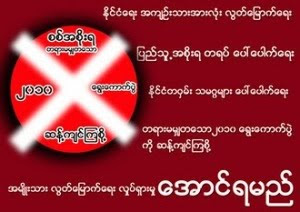Humanitarian Intervention စာဖတ္၀ိုင္း(၁)
အခုတေလာ R2P လို႔ေခၚတဲ့ Responsibility to protect ကိိိစၥက သိပ္နာမည္ၾကီးေနတာကလား။ ကမာၻအႏွံ႕မွာ R2P အေနနဲ႔ ျမန္မာႏိုင္ငံကို စစ္ေရးအရ ၀င္ေရာက္စြက္ဖက္ျခင္းျပဳဖို႔ ေတာင္းဆိုသံေတြ ျပန္႕ႏွံ႕ေနၾကတယ္။ အခ်ဳပ္အျခာအာဏာရွိတဲ့ ႏိုင္ငံတႏိုင္ငံကို ၀င္ေရာက္စြက္ဖက္မယ္ဆိုရင္ ၀င္ေရာက္စြက္ဖက္မွဳ (interventions) ေတြအားလံုးမွာ legitimacy ရွိရပါတယ္။ ဒီ legitimacy ကို judge လုပ္ႏိုင္မယ့္ specific criteria ေတတတြကို ေအာက္မွာ ေဖာ္ျပေပးပါတယ္။ International commission on Intervention and State Sovereignty report ထဲမွ ေကာက္ႏွဳတ္ေဖာ္ျပထားတာျဖစ္ပါတယ္။
THE RESPONSIBILITY TO PROTECT: CORE PRINCIPLES
(1) Basic Principles
- State sovereignty implies responsibility, and the primary responsibility for the protection of its people lies with the state itself.
- Where a population is suffering serious harm, as a result of internal war, insurgency, repression or state failure, and the state in question is unwilling or unable to halt or avert it, the principle of non-intervention yields to the international responsibility to protect.
(2) Foundations
The foundations of the responsibility to protect, as a guiding principle for the international community of states, lie in:
- obligations inherent in the concept of sovereignty;
- the responsibility of the Security Council, under Article 24 of the UN Charter, for the maintenance of international peace and security;
- specific legal obligations under human rights and human protection declarations, covenants and treaties, international humanitarian law and national law;
- the developing practice of states, regional organizations and the Security Council itself.
(3) Elements
The responsibility to protect embraces three specific responsibilities:
- The responsibility to prevent: to address both the root causes and direct causes of internal conflict and other man-made crises putting populations at risk.
- The responsibility to react: to respond to situations of compelling human need with appropriate measures, which may include coercive measures like sanctions and international prosecution, and in extreme cases military intervention.
- The responsibility to rebuild: to provide, particularly after a military intervention, full assistance with recovery, reconstruction and reconciliation, addressing the causes of the harm the intervention was designed to halt or avert.
(4) Priorities
- Prevention is the single most important dimension of the responsibility to protect: prevention options should always be exhausted before intervention is contemplated, and more commitment and resources must be devoted to it.
- The exercise of the responsibility to both prevent and react should always involve less intrusive and coercive measures being considered before more coercive and intrusive ones are applied.
The Responsibility to Protect: Principles for Military Intervention
(1) The Just Cause Threshold
Military intervention for human protection purposes is an exceptional and extraordinary measure. To be warranted, there must be serious and irreparable harm occurring to human beings, or imminently likely to occur, of the following kind:
- large scale loss of life, actual or apprehended, with genocidal intent or not, which is the product either of deliberate state action, or state neglect or inability to act, or a failed state situation; or
- large scale 'ethnic cleansing', actual or apprehended, whether carried out by killing, forced expulsion, acts of terror or rape.
(2) The Precautionary Principles
- Right intention: The primary purpose of the intervention, whatever other motives intervening states may have, must be to halt or avert human suffering. Right intention is better assured with multilateral operations, clearly supported by regional opinion and the victims concerned.
- Last resort: Military intervention can only be justified when every non-military option for the prevention or peaceful resolution of the crisis has been explored, with reasonable grounds for believing lesser measures would not have succeeded.
- Proportional means: The scale, duration and intensity of the planned military intervention should be the minimum necessary to secure the defined human protection objective.
- Reasonable prospects: There must be a reasonable chance of success in halting or averting the suffering which has justified the intervention, with the consequences of action not likely to be worse than the consequences of inaction.
(3) Right Authority
- There is no better or more appropriate body than the United Nations Security Council to authorize military intervention for human protection purposes. The task is not to find alternatives to the Security Council as a source of authority, but to make the Security Council work better than it has.
- Security Council authorization should in all cases be sought prior to any military intervention action being carried out. Those calling for an intervention should formally request such authorization, or have the Council raise the matter on its own initiative, or have the Secretary-General raise it under Article 99 of the UN Charter.
- The Security Council should deal promptly with any request for authority to intervene where there are allegations of large scale loss of human life or ethnic cleansing. It should in this context seek adequate verification of facts or conditions on the ground that might support a military intervention.
- The Permanent Five members of the Security Council should agree not to apply their veto power, in matters where their vital state interests are not involved, to obstruct the passage of resolutions authorizing military intervention for human protection purposes for which there is otherwise majority support.
- If the Security Council rejects a proposal or fails to deal with it in a reasonable time, alternative options are:
- consideration of the matter by the General Assembly in Emergency Special Session under the "Uniting for Peace" procedure; and
- action within area of jurisdiction by regional or sub-regional organizations under Chapter VIII of the Charter, subject to their seeking subsequent authorization from the Security Council.
- The Security Council should take into account in all its deliberations that, if it fails to discharge its responsibility to protect in conscience-shocking situations crying out for action, concerned states may not rule out other means to meet the gravity and urgency of that situation - and that the stature and credibility of the United Nations may suffer thereby.
(4) Operational Principles
- Clear objectives; clear and unambiguous mandate at all times; and resources to match.
- Common military approach among involved partners; unity of command; clear and unequivocal communications and chain of command.
- Acceptance of limitations, incrementalism and gradualism in the application of force, the objective being protection of a population, not defeat of a state.
- Rules of engagement which fit the operational concept; are precise; reflect the principle of proportionality; and involve total adherence to international humanitarian law.
- Acceptance that force protection cannot become the principal objective.
- Maximum possible coordination with humanitarian organizations.
ဒီ criteria ေတြနဲ႔ ျမန္မာျပည္အေရးကိုက္ညီျခင္းရွိႏိုင္မရွိႏိုင္၊ ျမန္မာႏိုင္ငံသို႔ ျပည္ပႏိုင္ငံတခုခုမွ ဒီ R2P ကိုသံုးျပီး ၀င္ေရာက္ျခင္းရွိႏိုင္မရွိႏိုင္စသည္မ်ားကို ေလ့လာေဆြးေႏြးၾကည့္ၾကပါရွင္။ က်ြန္မအေနနဲ႕ကေတာ့ အခ်က္အလက္ကို မွ်ေ၀ျခင္းသာ ျဖစ္ပါေၾကာင္း။


































